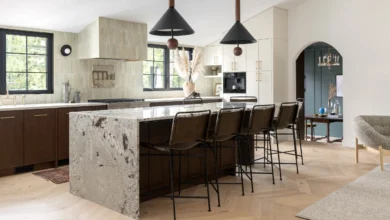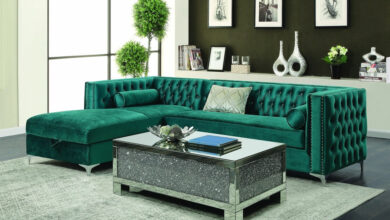What are the common materials used in bathtubs?
Choosing the proper bathtub might be a huge challenge. There are a lot of factors to consider when buying your first furniture, such as your budget and the right type of material for your situation. Some of the most prevalent bathtub materials and some of their advantages and disadvantages will be discussed in this article.
Acrylic
Acrylic tubs are a popular choice because of their many advantages, including durability, adaptability, low cost, and various design options. An acrylic bathtub is a great option because it is watertight, lightweight, and simple to install. Vacuum-formed acrylic sheets are strengthened with fiberglass to ensure the bathtub’s longevity.
Pros
- Durable
- Non-porous surface
- Affordable
- Available in various sizes, shapes, and colors
- Surface is repairable
- Lightweight
Cons
- Acrylic is significantly more expensive than fiberglass.
- Stress points need to be bolstered during the installation process
- Abrasive cleaners can easily cause scratches.
Alcove
Alcove tubs are the most cost-effective options available. Modern alcove bathtubs are lighter and less durable than tubs made of other materials, such as cast iron or fiberglass. Alcove reinforcement and polyester resin are used to make the alcove bathtubs.
Pros
- Affordable
- Easy to install
- Easily repaired
- Easy to clean and maintain
Cons
- Limited variety of color
- Less durable compared to other materials
- Finishing fades easily
- Prone to scratches and chips
Cast Iron
It’s better to use enameled cast iron if you want a traditional bathtub. The cast iron tubs are extremely sturdy, weighty, and strong. Enamel-coated molded iron is used to make cast iron tubs. As long as you don’t mind the weight, cast iron bathtubs are an excellent long-term investment option. Cast iron runs are difficult to carry and install because of their weight. The cast iron tub’s weight may necessitate additional structural support for the bathroom floor.
Pros
- Highly durable
- Highly resistant to crushing and chipping
- Impressive hear retention
- Timeless look
- Wide range of color and design
Cons
- Very heavy
Porcelain Enameled Steel
Ceramic-enameled steel bathtubs are also a popular and economical choice. A porcelain-enameled steel product is made by coating steel sheets with porcelain enamel and baking them. As with cast iron bathtubs, porcelain-enameled steel bathtubs are slightly heavier than fiberglass and acrylic models.
Pros
- Affordable
- Relatively lightweight
- Easy to maintain and clean
Cons
- Poor heat retention
- Produces noise if not insulated
- Limited variety of shapes and color
- The surface can dent or chip when objects fall on it
Stone
Stone bathtubs are preferable to acrylic bathtubs in terms of luxury, aesthetics, durability, heat retention, and ease of cleaning and maintenance. In terms of aesthetics and monetary value, stone bathtubs are unmatched.
Stone baths are enticing because of their longevity, heat retention, and organic appeal. In addition, they’re a hefty price and weight. Stone bathtubs may necessitate additional structural support since they are so heavy.
Pros
- High-end investment
- Natural look
- Durable
- Sturdy
- Custom-ordered
Cons
- Additional support required
- Very heavy
- High-maintenance
Stone Resin
Stone Resin is one of the most popular and widely available bathtub materials. Stone resin bathtubs, which combine polymer resin with natural stone, lack class and luxury.
If you care about the environment, you won’t have any trouble finding stone resin bathtubs made from 100% recyclable materials. These bathtubs are sturdy, robust, and long-lasting. But that’s not all; the stone resin substance is relatively inexpensive compared with travertine or marble stone bathtubs.
Pros
- Eco-Friendly
- Durable
- Luxurious aesthetic
- High heat retention
- Affordable
Cons
- Heavy
- We may need structural floor support.
Copper
Even though copper bathtubs are rare in modern bathrooms, they are an excellent material for constructing such a fixture. Copper bathtubs bring elegance and refinement to most bathrooms and a sense of warmth, thanks to their hue.
Regarding structural durability, copper bathtubs are unbeatable because of their natural resistance to dents and scratches. Even if scratches appear, they will fade away because copper is a natural hue that changes over time.
On the other hand, copper bathtubs are quite expensive due to the high cost of the materials and the high cost of specialist craftsmanship needed to build copper bathtubs.
Pros
- Low maintenance
- Resistant to mold, bacteria, and scratches
- Durable
- Aesthetic appeal
Cons
- Very expensive
- Rare and difficult to find
- Limited variety of sizes, models, and shapes
Wood
Adding a wooden bathtub to a bathroom is always a good idea. A bathroom with a wooden bathtub has a distinct and luxurious feel. The downsides of wooden bathtubs include their high price and the fact that they are prone to cracking over time. Because wood is so malleable and adaptable, choosing a wooden bathtub that suits your style is easy. There are several advantages to wooden bathtubs over other tubs, such as their greater depth and size.
Pros
- Custom ordered
- Natural look
- High-end investment
Cons
- High-maintenance
- Expensive
Cast Polymer
Solid surface materials and designed natural stone are found in cast polymer bathtubs. Cast polymer bathtubs resemble marble, granite, and onyx because of their look. Molding resins, minerals, and polymeric materials into a solid form create these bathtubs. Solid-surface countertops like Corian, for example, are remarkably similar in appearance to the resulting solid substance. Tubs are covered with gel coats after molding to ensure optimum finishing.
For bathroom refurbishment and renovation, cast polymer materials are a cost-effective option. A wide variety of colors, forms, and styles are available for the bathtubs. Unfortunately, cast polymer bathtubs have a serious drawback: their surfaces wear down over time. Cast polymer bathtubs, as a result, are susceptible to cracking with regular use. You need always keep an eye on this type of tub and replace it if necessary.
Pros
- Affordable
- Wide variety of shapes, designs, and color
- Easy to maintain and clean
- Resistant to stain
- Scratches and chips can be easily buffed out.
Cons
- Relatively durable (not the best in terms of durability)
- Wearing a gel coat can result in unbearable damage.
Ceramic Tiles
A ceramic tile is a piece of inorganic material (typically clay) that has been heated to solidify and coated with a glaze before it is used in an application. Bathtubs can benefit from ceramic tile because of its durability, ease of washing and ability to keep bacteria at bay.
There is a wide variety of sizes, shapes, and colors available in ceramic tile bathtubs. Uneven tiles and grout can be irritating on exposed skin, however. Individual ceramic tiles must be set on a prepared surface using the proper trowel and mortar because of their enormous range of forms and shapes.
Pros
- A wide range of styles, shapes, and colors to choose from.
Cons
- Not quite simple to install
- It can be uncomfortable on the bare skin
- High maintenance
- Expensive
What is the best material for a bathtub?
Choosing the right material for bathtubs is a difficult task. If you want a bathtub for your bathroom, you’ll have to choose one based on your preferences. It would help if you weighed the benefits and drawbacks of the various materials before settling on one for your bathroom. Fiberglass and acrylic bathtubs are your best bet if you’re looking for an inexpensive, lightweight, and long-lasting bathtub. Because these materials are heavier and more lasting, they’re great if you want a bathtub that retains high temperatures for long periods. The hardwood and copper bathtub, on the other hand, is ideal for those seeking a more upscale look.
Conclusion
A bathtub made of any of the materials listed above will fulfill your needs for both function and beauty. Most people would agree that the finest material for a bathtub is light, resilient, and resistant to mildew, as well as one that maintains heat well and is simple to clean. Above all else, the greatest bathtub material must be compatible with your taste and budget. It’s nearly impossible to find a bathtub that fits all of these criteria. As a result, you must carefully weigh the advantages and disadvantages of various bathtub materials before deciding on the best option.




